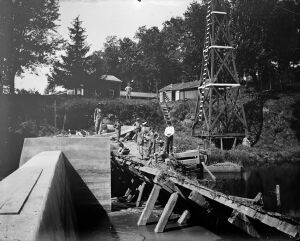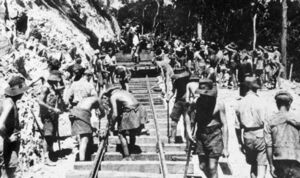Aufaigaluega Faapitoa Faufale
The Aufaigaluega Faapitoa Faufale (AuFaFa), or Special Personnel Construction Forces is a labor force organized under the Stenzan Army.

History
Cheap, forced labor under the oversight of the military has been a thing since the Daxian colonial occupation of Stenza, with political prisoners and other unwanted Stenzans being forced to work for the Daxian settlers. Most Daxian settlements were built on the backs of these laborers, with de facto slavery being common around Stenza. Laborers were under immense physical pressure, with the Daxian punishing all who did not keep up the high tempo until they died. Work in these labor units commonly led to the spread of revolutionary thoughts against the Daxian colonial government, with revolts by these penal units not being uncommon. Most of these revolts were put down with force however, maintaining the status quo through violence.
The word of the Stenzan Revolution spread through the labor units like wildfire, with many labor units overpowering their Daxian guards to take up arms. These units were already quite organized after years of labor and, with the right arms, proved to be a very motivated and effective fighting force set on taking down their once oppressors. Many war heroes had their roots in these units, which fought with great merit during the war.
The Stenzan Civil War that followed the revolution saw the reinstatement of penal units under their new name, with deserters, prisoners of war and political prisoners being put to work to maintain the Party-aligned army's supply lines. The name Aufaigaluega Faapitoa Faufale was first used around this time for the units constructing the railways and camps that served the army. It is worth mentioning that various penal units also fought in the civil war, usually forced to do so by politcal commissars in second rate positions or as cheap gun fodder, those unwilling to fight would be shot instead. Those who fought in penal units with dedication and devotion to the cause they were forced to support were freed after the war, being allowed to continue their lives as normal Stenzan citizens.

After the civil war, the AuFaFa units were kept to put Prisoners of War and other opponents from the civil war to work for the utility of the new Stenzan nation. The country, which was still largely rural at this point, had great ambitions to at some point become a modern power, and major infrastructural and urbanization projects were undertaken over the next decades to lift Stenza out of poverty. Throughout this time, the units were organized properly and would contain regular convicts, political dissidents, military deserters and other people the government desired to go away, providing a constant workforce the government would use to build railways, roads, airports, bridges, hydro-electric dams and much more. Political dissidents regularly disappeared through these units, suffering tragic 'worksite accidents' at the Party's leisure.
The Stenzan Party would continue to employ these units throughout their existence, and even beyond. Current day Stenza still has penal units, with the public widely supporting the decision to put convicts to work instead of letting them waste tax money inside prisons. Forced labor is the most common punishment handed out by Stenzan judges, and the AuFaFa form the backbone of Stenza's judicial system. Current day labor units provide the opportunity for well-behaved laborers to learn specific trades to set them up for post-conviction life, and stellar performers can be offered a regular position within Stenza's armed forces once they serve their sentence. Non-commissioned officers in these units can be senior convicts as well. Convicts are generally positive about their experiences in the modern day penal units, claiming they are tough but fair ways to serve their sentences. Those who finish their sentences may be allowed to stay around as non-commissioned officers if their criminal record allows it, mentoring other convicts and honing their vocational skills.
Organization
Aufaigaluega Faapitoa Faufale units are organized at an autonomous company level, with larger battalion level organizations existing to handle personnel and auxiliary affairs. AuFaFa companies are generally of reinforced company size, with one security platoon and multiple labor platoons that can be augmented with regular army engineers to provide specific trade knowledge and specialized tools. Labor companies are autonomous enough to tackle a specific construction project individually, although multiple companies can work together on large scale projects. The companies tend to be supported by an accommodation platoon, taking care of providing a safe campsite with a sleeping area, eating area and washing area.

Discipline within the AuFaFa units is harsh. New arrivals are instructed that convicts will be shot if they try to escape or revolt, and lethal punishment is authorized to keep the discipline within the penal units. Historically, security within penal units was very tight, with security forces using armored vehicles and heavy weaponry to discourage escapes. Those who did escape could expect the full brunt of the local military forces to make sure punishment would be delivered. Modern day security is a bit more lenient, with morale and discipline in the units being higher. The attached security platoon can still rely on mechanized equipment to catch up with any escapee, with thermal equipment making it easy to spot those trying to escape through night and day. Penal units can still rely on attack helicopters to back them up in the event of an actual escape, sniffing out and eliminating escapees. Escape attempts are limited to a few times a year, and the consequences of those escape attempts are highly publicized to fend off further escape attempts.
Alleged Daxian labor
Main article: Cathay Transient Workers Protocol
It is alleged that special Aufaigaluega Faapitoa Faufale units exist manned with Cronan laborers exported by Daxia under the Cathay Transient Workers Protocol. The Stenzan government has repeatedly denied these rumors, although pictures of Cronan-looking individuals working in Stenzan military fatigues have spread online. The matter is the subject of mild controversy across Stenza, although most are just happy to see people work to improve the country. The allegations hint at the fact Stenza pays a relatively cheap amount of money for these laborers. Concerns about the humanity of using foreign laborers and treating them like convicts have been voiced internationally, especially seeing rumors exist that Cronan laborers who try to escape are dealt with the seme way Stenzan escapees are punished; With a bullet.
